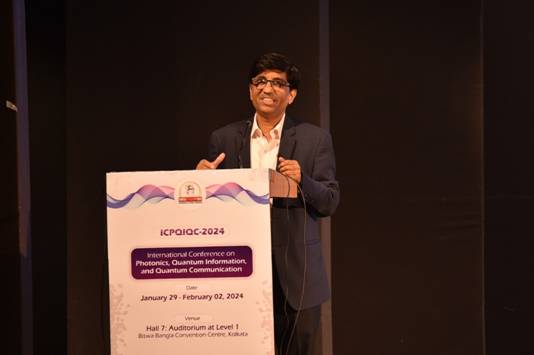Dignitaries trace the evolution of quantum mechanics on 100 years of S N Bose’s colossal work
Distinguished scientists and scientific administrators, brought together on the occasion of the celebration of 100 years of the historic occasion when Satyendra Nath Bose authored the last of the four revolutionary publications that led to new quantum mechanics, traced the evolution of quantum mechanics through the years.
Professor Ajay Sood, Principal Scientific Adviser to the Government of India, speaking at the inauguration of the 5-day long International Conference on Photonics, Quantum Information and Quantum Communication organised by the S N Bose National Centre for Basic Sciences (SNBNCBS) in Kolkata, pointed out that we are passing through the second revolution in Quantum Mechanics and that the gap between fundamental science and technological intervention is closing.
“A total of 750 million USD are being applied in four verticals. It is a wonderful time for all of us to be a part of this new mission. The right problems that are solvable and have wide applications will have to be addressed by researchers. Quantum sensing, satellite-based quantum communications and post quantum cryptography are some of the areas that need to be focused on,” he added.
He stressed that 23 countries have set up National Quantum Missions and India has a substantial contribution to make at an international level, specially in the field of quantum algorithms.
“After 100 years we are witnessing that the concepts of fundamental science are being deployed in a big way in areas of communication, computing, and other applications. With the National Quantum Mission (NQM) gathering steam, we have an opportunity to play at the global scale. The Mission will open the quantum science and technology domain for international collaboration. Four mission hubs will be set up across the country. Each hub is expected to bring together all technical experts in a consortium mode,” Secretary, Department of Science and Technology (DST), Prof. Abhay Karandikar emphasised.
He added that the students and the experts could also make significant contributions to the NQM through ecosystem of startups that has developed in the country and through the four mission hubs to be established across the country to bring together all technical experts in a consortium mode to work on accelerating the working of the NQM.
He also highlighted the role of the Anusandhan National Research Foundation for creating a congenial atmosphere for research in the country.
This international conference is the first programme of the yearlong celebration of the 100 years of the historic occasion. The yearlong celebration will include three International Conferences and several Outreach Programmes which SNBNCBS, an autonomous institution of DST,will be organizing throughout the year.
Prof. Tanusri Saha-Dasgupta, Director of S.N. Bose National Centre, said that Satyendranath Bose’s seminal paper was published in 1924 after it was translated in German by Einstein. She added that scientists from different parts of the world and from different states of India, students and media persons are participating in the programme to exchange their views, share their research findings and draw inspiration from each other.
Satyendra Nath Bose’s pioneering work on quantum statistics has paved the way for development of modern quantum technologies including Bose-Einstein condensation, quantum superconductivity, and quantum information theory. In 1924, Bose authored the last of the four revolutionary publications that led to the new quantum mechanics (the others being those of Planck in 1900, Einstein in 1905, and Niels Bohr in 1913). Half the fundamental particles in the Universe are named after him – BOSON. He derived Planck’s law in a revolutionary way which impressed Einstein, and subsequently they continued to collaborate.
Their partnership resulted in new physical theories, including Bose-Einstein statistics and the Bose-Einstein condensate. Several Nobel Prizes were later awarded for work related to the boson; the force-carrying particles named after Bose himself.
Along with developing the new quantum statistics, Bose’s work also constitutes the foundation of novel technologies which also finds applications in the Second Quantum Revolution.
S. N. Bose National Centre for Basic Sciences, an Autonomous Research Institute established under Department of Science and Technology (DST), Government of India in 1986 to honour the life and work of Professor S. N. Bose, is celebrating the centenary of Bose’s colossal work in theoretical physics in 2024 by organizing International Conferences and Outreach Programmes throughout the year. While the Conferences will provide opportunities for experts, including Nobel laureates, across the globe to come together and exchange their ideas, the Outreach Programmes will create momentum towards popularising science.



